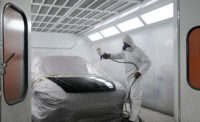PPG Receives DOE Award to Develop New Class of Pigments for Cool Coatings

PITTSBURGH – PPG Industries’ industrial coatings business has received a $224,000 award from the U.S. Department of Energy (DOE) to help develop dark-colored pigments for cool metal roof and façade coatings that incorporate near-infrared (NIR) fluorescence and reflectance to improve energy performance.
The award is part of a $530,000 project that includes a $250,000 award to the Lawrence Berkeley National Laboratory (Berkeley Lab) to partner with PPG on the research and $56,000 in cost-sharing by PPG.
While painting a metal roof white is the simplest way to keep the sun’s energy from heating a building’s interior, most consumers will do so only if the roof is flat. For sloped roofs, they prefer darker coatings that absorb more visible light, including many that also absorb more invisible NIR solar radiation. Because colors absorb more solar energy as they get darker, buildings with dark-colored roofs are warmer and more expensive to cool than buildings with white roofs.
To combat this problem, PPG makes products such as ULTRA-COOL®coatings that reflect invisible NIR radiation, but dark ULTRA-Cool coatings still absorb visible light energy that is ultimately converted into heat.
The goal of the PPG/Berkeley Lab program is to develop a more advanced class of dark-colored pigments that can convert a portion of the absorbed visible light energy into NIR energy that is radiated away from buildings.
The new pigment technology under investigation would be a significant advance over current cool-coating pigments. PPG and Berkeley Lab estimate that cool coatings based on the new pigment technology could achieve effective solar reflectance (ESR) values of 0.5 to 0.7 compared to ESR values of 0.1 to 0.3 for standard pigments. An ESR improvement of 0.4 and widespread deployment of coatings with these pigments for residential applications in warm and hot areas of the United States could save up to $1.3 billion annually in related energy costs.
Bill Retsch, PPG Associate Director of Research, Industrial Coatings, said that when PPG learned that Berkeley Lab was investigating a new class of cool pigments, it immediately began looking for ways to support the project. “PPG and Berkeley Lab are focused on fundamentally understanding these pigments and how to incorporate them into coatings so they can provide the greatest energy benefit,” he explained. “We appreciate the support we have received from the DOE to investigate truly cutting-edge energy-efficient concepts.”
PPG recently partnered with Berkeley Lab’s Heat Island Group to study the effects of dirt build-up on cool roof coatings and with Berkeley Lab’s Windows & Daylighting group to examine energy-efficient window designs. PPG maintains a portfolio of research projects to advance sustainable building and design.
Looking for a reprint of this article?
From high-res PDFs to custom plaques, order your copy today!






